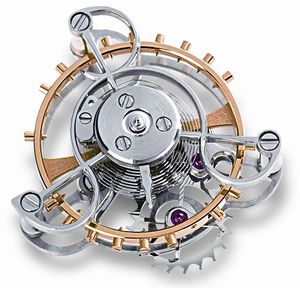Tourbillon/en: Unterschied zwischen den Versionen
Zur Navigation springen
Zur Suche springen
| Zeile 1: | Zeile 1: | ||
'''Tourbillon''' | '''Tourbillon''' | ||
| − | {{other languages|[[Tourbillon|de]]|[[Tourbillon/fr|fr]]|[[Tourbillon/nl|nl]]}} | + | {{other languages|[[Tourbillon|de]]|[[Tourbillon/fr|fr]]|[[Tourbillon/nl|nl]]|[[Турбийон|ru]]}} |
[[Bild:Tourbillon-Kaefig.JPG|thumb|Tourbillon Käfig]] | [[Bild:Tourbillon-Kaefig.JPG|thumb|Tourbillon Käfig]] | ||
A tourbillon is an addition to the mechanics of a watch escapement. Invented in [[1795]] by French watchmaker [[Abraham-Louis Breguet]], a tourbillon counters the effects of gravity by mounting the escapement and balance wheel in a rotating cage, ostensibly in order to negate the effect of gravity when the timepiece (and thus the escapement) is rotated. | A tourbillon is an addition to the mechanics of a watch escapement. Invented in [[1795]] by French watchmaker [[Abraham-Louis Breguet]], a tourbillon counters the effects of gravity by mounting the escapement and balance wheel in a rotating cage, ostensibly in order to negate the effect of gravity when the timepiece (and thus the escapement) is rotated. | ||
Version vom 20. Dezember 2008, 19:40 Uhr
Tourbillon
| other languages: de fr nl ru |
A tourbillon is an addition to the mechanics of a watch escapement. Invented in 1795 by French watchmaker Abraham-Louis Breguet, a tourbillon counters the effects of gravity by mounting the escapement and balance wheel in a rotating cage, ostensibly in order to negate the effect of gravity when the timepiece (and thus the escapement) is rotated.
